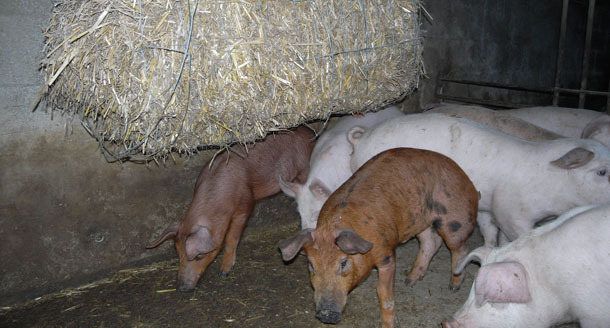Directive 2001/93/CE establishes that ”pigs must have permanent access to a sufficient quantity of material to enable proper investigation and manipulation activities, such as straw, hay, wood, sawdust, mushroom compost, peat or a mixture of such, which does not compromise the health of the animals”. This order does not distinguish in any way between new, old or reformed facilities, therefore these requirements will have to be fulfilled for all existing herds in the national territory from 15 March 2004.
Today this order is still not being fulfilled in the majority of our enterprises due to a backwardness in the culture and the training of our farmers and of many employees in the sector.


Despite the time that has passed the substantial steps required for its application have not been taken due to the fear, which is only real in some cases, that the manipulation material could be more detrimental than beneficial, the difficulty to explain its necessity for the animals and the hope that the typology of the structures will be enough to define the normative as inapplicable.
It is a good idea to define some aspects of the normative that, for some, might seem unclear.
Having permanent access means having availability, not ad libitum supply on the floor. Mastication, ingestion and interest in materials such as straw, alfalfa, cornstraw, etc, is compatible with small scatterings on the floor (and consequently, in the under-slat manure management system, in this way the application of the normative is possible on slat floors.
Sufficient quantity: indicates the possibility of access to the material in every moment of the day, so that the recourse does not create competitivity.
Exploration and manipulation: activity that the pig makes with the snout, which is very conditioned by the availability of material. The lack of access to suitable material means the pig will root about less, and an important behavioural manifestation of the pig will be impeded or reduced, whether in the wild or on a farm. "Poor" surroundings leads to frustration and sometimes to redirected behavior. A low or non-existent level of rooting can NEVER be associated to an adaptation of the pig to its surroundings, and only to a pathologic and violent alteration of its behavioural repertoire.
For example: the use of the relative pronoun defines the materials described as an incomplete list of materials; however, an experienced reader would complete the same list with materials that were similar in resemblance or finality (coconut fibre, alfalfa, etc.). Adding entertaining elements such as tyres, chains, plastic or rubber objects is a forced interpretation; indeed the European Commission has already defined their use as only a back-up to the destructible materials.
Unless its use can compromise health or welfare: it is difficult to imagine a case in which the materials mentioned on the list (correctly used) could alter, directly or indirectly, the welfare of the pig. For example, if it were accepted that the use of mildewed corn straw could be harmful for the pigs, this would not justify the absence of other materials, neither would it annul the use of better conserved straw.
Use of chains
One particular case that deserves a brief examination is the use of chains. The application of a chain that hangs from above, in the middle of the box, and that arrives to the height of the pig's shoulder, is widely used in Italy. From tests carried out by many farmers, it has been observed that the attraction towards the chain is long lasting, and it is a good method to restrict undesired redirected behaviour.
Points in favour of using the chain:
- it stays clean,
- it makes a sound,
- it is adaptable to play,
- it moves with the simple contact of the animals,
- it attracts the animal for a long time,
- it is durable,
- there is no risk to the pig's health or to the efficiency of the installations.
Unfortunately the chain also has some disadvantages:
- the pig's interest is manifested in an upraised position, which is not very natural in relation to its normal behaviour in natural conditions;
- the activity permitted by the chain is only of a manipulative, and not an exploratory kind;
- it has no dietary role;
- it is available to only a few individual animals at any one time which can lead to competitive type phenomena.
As we have already said, unfortunately the European Commission has judged negatively the use of chains as exploratory material, maintaining that materials such as chains or tyres (indestructible materials) can only be complementary materials to the destructible materials.


